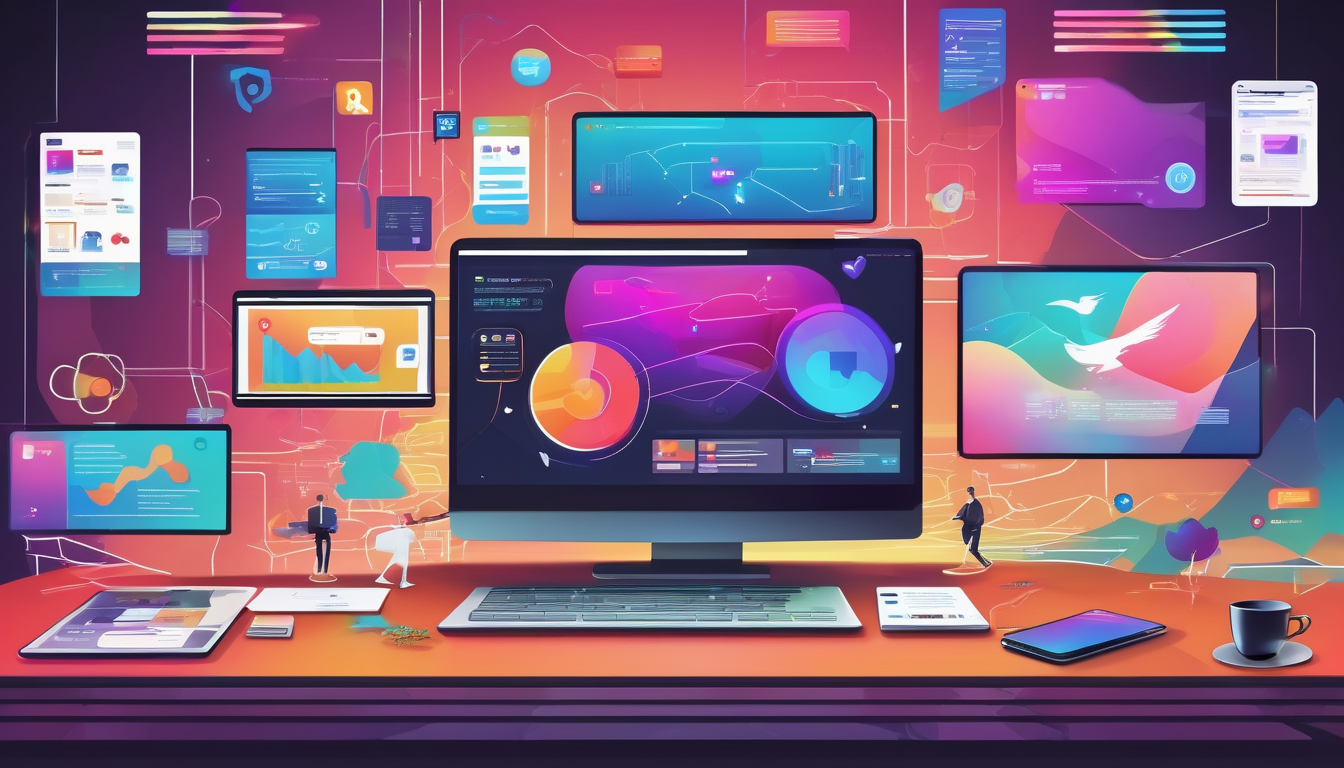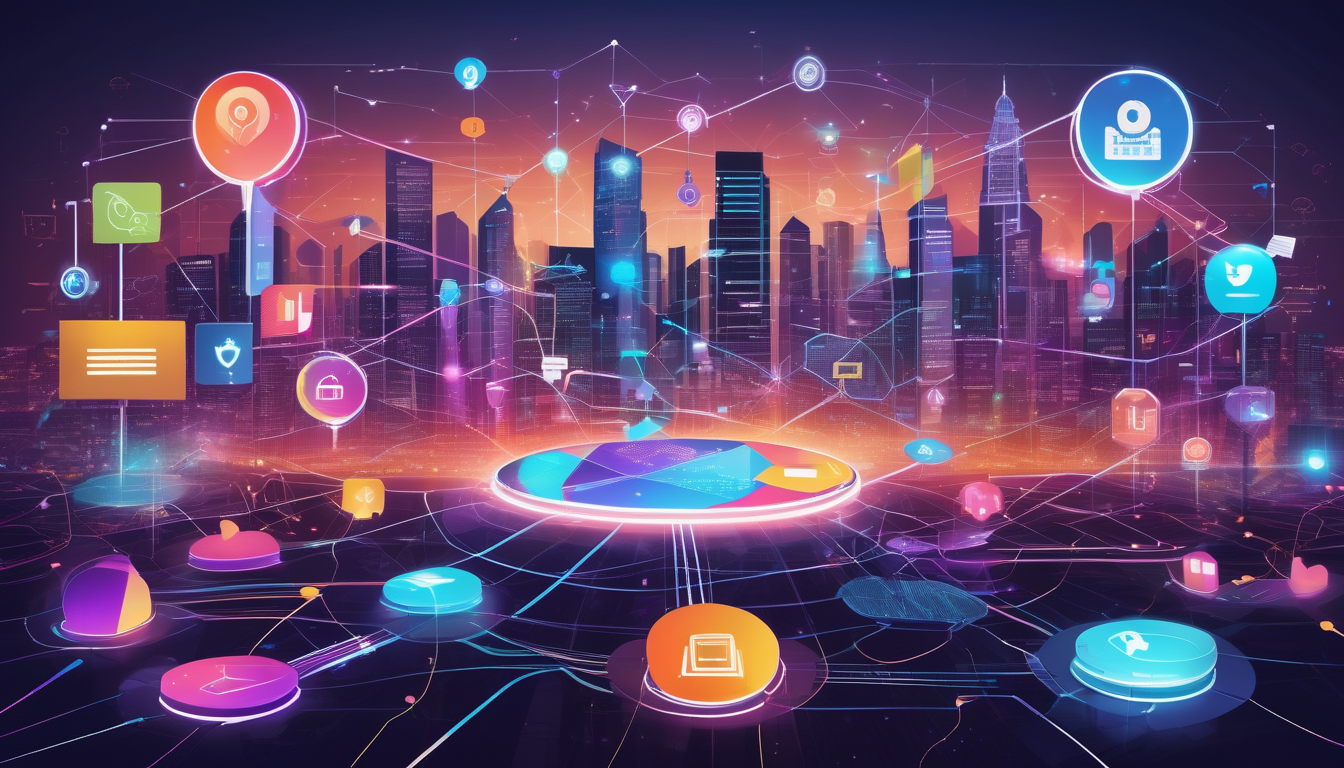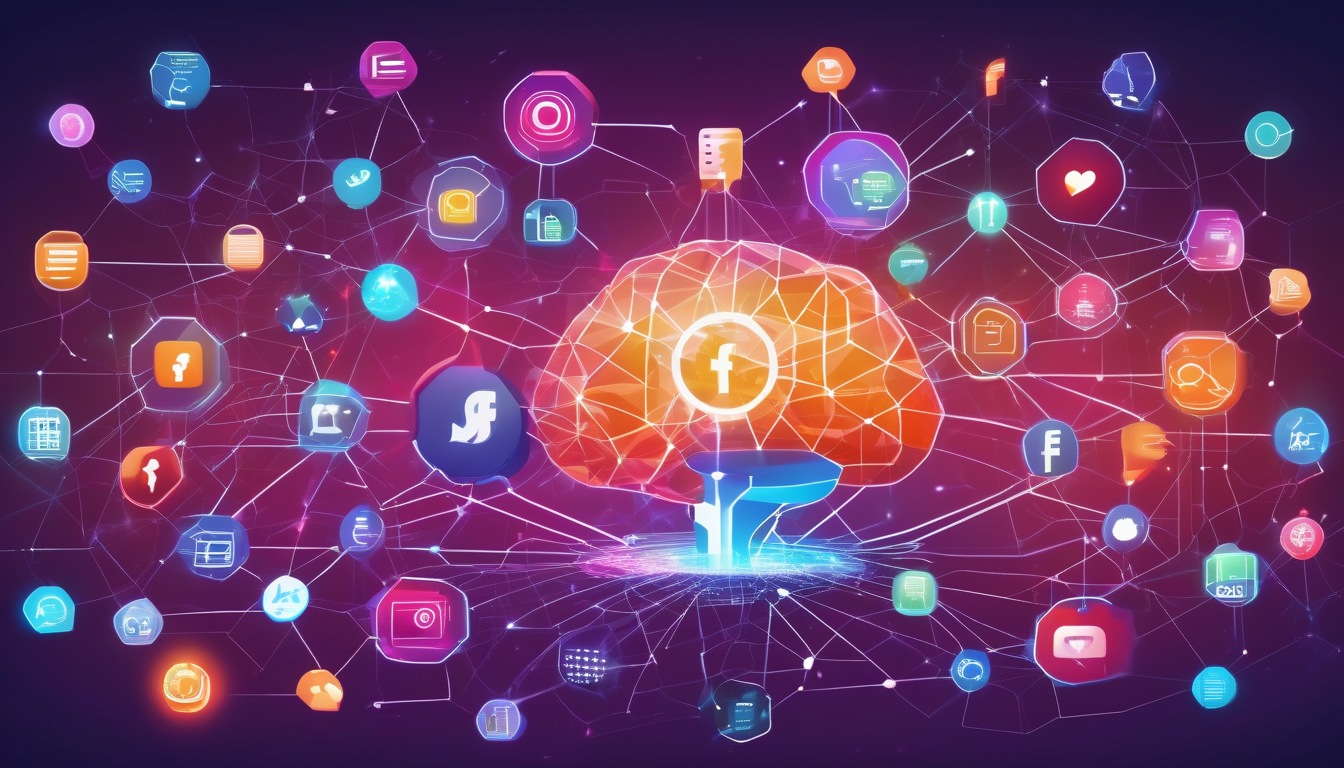This article explores how artificial intelligence is transforming social media, enhancing user experience, and shaping the future of digital interactions. We’ll discuss trends, challenges, and the potential impact on society.
AI is revolutionizing content creation on social media, enabling users and brands to generate engaging posts quickly and efficiently. Discover how tools like automated writing and image generation are changing the landscape of digital communication. Imagine being able to create captivating graphics or compelling text with just a few clicks—this is the power of AI. With platforms like Canva and Copy.ai, users can produce professional-quality content without needing extensive design or writing skills.
Artificial intelligence is improving user engagement by personalizing content and interactions. Learn how algorithms analyze behavior to recommend posts, foster connections, and keep users actively involved on various platforms. It’s like having a personal assistant who knows your preferences inside out! This tailored experience not only boosts interaction rates but also enhances user satisfaction, creating a community that feels more connected.
Chatbots powered by AI are becoming essential for customer service on social media. Explore how these virtual assistants enhance user experience by providing instant responses and support to inquiries. With the ability to handle thousands of queries simultaneously, chatbots ensure that no customer is left waiting.
AI chatbots provide round-the-clock assistance, ensuring users receive timely help regardless of time zones. This constant availability improves customer satisfaction and strengthens brand loyalty. Imagine needing help at 2 AM and getting instant answers—this is the new norm!
Advanced AI chatbots can manage complex customer queries, offering tailored solutions and reducing the need for human intervention. This capability enhances efficiency and streamlines communication, allowing human agents to focus on more intricate issues.
AI algorithms play a crucial role in content moderation, identifying inappropriate or harmful content swiftly. Understand how these systems help maintain safe online environments for users. By analyzing vast amounts of data in real-time, AI can flag harmful posts, keeping social media spaces more secure.
As AI becomes more prevalent in social media, concerns about data privacy and ethical considerations arise. Examine the challenges and responsibilities that come with utilizing AI technologies in this space. It’s crucial for companies to navigate these waters carefully to maintain user trust.
The need for transparency in AI algorithms is paramount to building trust. Explore how companies can ensure users understand how their data is used and how decisions are made. Clear communication about data practices can alleviate user concerns and foster a sense of security.
Addressing bias in AI systems is essential for fair representation on social media. Discover strategies to mitigate bias and ensure equitable treatment for all users. By prioritizing diversity in training data and continuously monitoring AI outputs, platforms can work towards a more inclusive environment.
AI is changing the role of influencers on social media, enabling them to reach audiences more effectively. Learn how analytics and AI tools are shaping influencer marketing strategies. With data-driven insights, influencers can tailor their content to resonate more deeply with their followers.
AI enables influencers to develop targeted marketing strategies based on audience insights. Understand how data-driven decisions enhance campaign effectiveness and engagement rates. This precision in targeting helps brands connect with their ideal customers, maximizing impact.
As AI-generated content rises, authenticity and trust may be challenged. Explore how influencers can maintain credibility in an era of AI-driven communication. By being transparent about their use of AI tools and focusing on genuine interactions, influencers can uphold their integrity.
The future of AI in social media is promising, with emerging technologies continuously reshaping the landscape. Discover the anticipated trends and innovations that will define the next generation of digital interaction. As we look ahead, the integration of AI with technologies like augmented reality (AR) and virtual reality (VR) will create immersive experiences that redefine how users interact with content.
The integration of augmented reality (AR) and AI is set to enhance user experiences on social media. Explore how these technologies will create immersive environments for users, allowing them to engage with content in ways previously unimaginable.
AI will play a significant role in developing virtual reality (VR) experiences on social media platforms. Understand how these advancements will transform user interactions and content consumption, paving the way for a new era of social engagement.

AI-Powered Content Creation
In today’s fast-paced digital world, AI is revolutionizing content creation on social media platforms, enabling both users and brands to produce engaging posts with remarkable speed and efficiency. Imagine being able to create a captivating blog post or an eye-catching image in mere minutes! This technological advancement is not just a trend; it’s a game-changer that is reshaping how we communicate online.
Tools powered by artificial intelligence, such as automated writing assistants and image generation software, are becoming increasingly accessible. These tools analyze existing content and user preferences to generate new material that resonates with target audiences. For instance, AI can suggest headlines, optimize keywords, and even generate visuals that align with the brand’s identity. This streamlined process saves time and resources, allowing creators to focus on what truly matters: connecting with their audience.
But how does this all work? AI algorithms utilize vast amounts of data to understand trends and user behavior. By doing so, they can provide personalized content recommendations that enhance user engagement. Consider the following benefits of AI-powered content creation:
- Increased Efficiency: AI tools can produce content at a pace that humans simply cannot match.
- Consistency: Brands can maintain a uniform tone and style across all posts, enhancing brand recognition.
- Data-Driven Insights: AI analyzes audience interactions, helping creators refine their strategies.
As we move forward, the integration of AI in content creation will only deepen. The challenge lies not just in the technology itself but in how we leverage it responsibly. While AI can enhance creativity, it’s essential to ensure that the human touch remains in our communications. After all, the heart of social media is about building connections, and no algorithm can replace the genuine emotion behind a well-crafted message.

Enhanced User Engagement
Artificial intelligence is not just a buzzword; it’s a game-changer in how we interact on social media. Imagine scrolling through your feed and seeing posts that resonate with your interests so perfectly that it feels like the platform knows you personally. That’s the magic of AI! By analyzing user behavior, AI algorithms can tailor content recommendations that keep users engaged and coming back for more.
These algorithms work tirelessly behind the scenes, processing vast amounts of data to understand what you like and dislike. This means that the more you interact with content, the better the platform becomes at serving up posts that align with your preferences. It’s like having a personal assistant who knows exactly what you want to see. For instance, if you frequently engage with travel content, AI will prioritize travel-related posts in your feed, making your experience more satisfying.
Moreover, AI doesn’t just stop at recommending content. It also fosters connections between users, enhancing the social aspect of social media. By analyzing mutual interests and interactions, AI can suggest new friends or groups that align with your hobbies, expanding your network effortlessly. This personalized approach not only boosts user engagement but also creates a sense of community, which is essential in today’s digital age.
However, it’s worth noting that while AI brings many advantages, it also poses challenges. For instance, the risk of echo chambers arises when users are only exposed to content that reinforces their existing beliefs. It’s crucial for platforms to balance personalization with diversity in content to ensure a healthy user experience. Ultimately, the goal of AI in enhancing user engagement is to create a vibrant, interactive space where everyone feels valued and connected.
Chatbots and Customer Service
In today’s fast-paced digital world, chatbots have become a game-changer for customer service on social media platforms. Imagine having a virtual assistant that never sleeps, always ready to help you at any hour of the day. That’s the magic of AI-powered chatbots! They are designed to provide instant responses to user inquiries, making interactions smoother and more efficient.
These digital assistants can handle a wide range of tasks, from answering frequently asked questions to providing personalized recommendations. For instance, if a user is curious about a product, a chatbot can quickly pull up relevant information and even guide them through the purchasing process. This not only enhances the user experience but also significantly reduces wait times, which can often lead to frustration.
Let’s take a moment to explore some key advantages of using chatbots for customer service:
- 24/7 Availability: Unlike human agents, chatbots can operate around the clock, ensuring that users receive assistance whenever they need it, regardless of time zones.
- Handling Complex Queries: Advanced AI chatbots are equipped to manage more intricate customer queries, providing tailored solutions without the need for human intervention.
- Cost Efficiency: By automating routine inquiries, businesses can save on labor costs while maintaining high levels of customer satisfaction.
Moreover, chatbots can be integrated with other AI technologies, such as sentiment analysis, to gauge the emotional tone of customer interactions. This means they can adapt their responses based on whether a user is happy, frustrated, or confused, making the conversation feel more natural and engaging. As we look to the future, the role of chatbots in customer service is only expected to grow, paving the way for more dynamic and interactive user experiences.
24/7 Availability
In today’s fast-paced digital world, the expectation for immediate responses is higher than ever. This is where AI chatbots step in, providing round-the-clock assistance to users across various social media platforms. Imagine needing help at midnight, and instead of waiting for hours, you get instant answers. That’s the magic of AI! With these virtual assistants, users can receive timely support regardless of their time zone, making it easier for brands to cater to a global audience.
Furthermore, the constant availability of AI chatbots not only enhances customer satisfaction but also strengthens brand loyalty. Users feel valued when they can access help whenever they need it. Consider this: a user sends a message at 3 AM and receives an immediate response. This level of service can turn a casual user into a loyal customer, as they appreciate the efficiency and reliability of the brand.
AI chatbots are designed to handle a variety of inquiries, from simple questions to more complex issues. Here are some key benefits of 24/7 availability:
- Instant Response: Users don’t have to wait for business hours to get help.
- Increased Engagement: Continuous support keeps users interacting with the brand.
- Cost-Effective: Businesses can save on customer service costs while enhancing user experience.
As AI technology continues to evolve, we can expect even more sophisticated chatbots that not only respond to queries but also learn from interactions. This means that the more they engage, the better they become at providing tailored solutions. In a world where time is money, the of AI chatbots is not just a convenience; it’s a necessity for brands looking to thrive in the competitive landscape of social media.
Handling Complex Queries
In today’s fast-paced digital world, customers expect quick and accurate responses to their inquiries. This is where AI chatbots come into play, transforming how businesses handle complex queries. Unlike traditional customer service methods, which often involve long wait times and multiple transfers, AI-powered chatbots can efficiently manage intricate questions and provide tailored solutions.
Imagine having a personal assistant available at any hour, ready to tackle your most pressing questions. AI chatbots leverage advanced algorithms to analyze user input, allowing them to understand context and provide relevant answers. This capability not only enhances the user experience but also significantly reduces the workload on human customer service representatives.
For instance, when a customer asks about a specific product’s compatibility with other items, a well-designed AI chatbot can:
- Quickly retrieve product specifications
- Cross-reference compatibility data
- Offer personalized recommendations based on user preferences
This level of efficiency is a game-changer for businesses, as it helps streamline communication and ensures that users receive the information they need without unnecessary delays. Moreover, AI chatbots can learn from previous interactions, continually improving their responses to complex queries over time.
However, it’s important to recognize that while AI chatbots are incredibly capable, they are not infallible. There are instances where a customer’s question may require human intervention, particularly in emotionally charged situations or when dealing with sensitive issues. Therefore, a successful strategy involves a harmonious blend of AI technology and human oversight, ensuring that users feel valued and understood.
As we move forward, the ability of AI chatbots to handle complex queries will only improve, paving the way for more sophisticated customer service solutions that enhance user satisfaction and loyalty. This evolution not only benefits businesses but also creates a more engaging and responsive digital environment for all users.
Content Moderation
In today’s digital landscape, has become a vital aspect of social media platforms. With millions of posts shared every minute, ensuring that users engage in a safe and positive environment is crucial. This is where artificial intelligence (AI) steps in, acting like a vigilant guardian that monitors and filters content in real-time. Imagine AI as a digital bouncer, checking IDs at the door to ensure only appropriate content gets in.
AI algorithms are designed to swiftly identify and flag inappropriate or harmful content, such as hate speech, graphic violence, or misinformation. By analyzing patterns and context, these systems can effectively discern between acceptable posts and those that violate community guidelines. For instance, a simple image of a protest might be interpreted differently than a graphic image promoting violence, showcasing the nuanced understanding AI can bring to content moderation.
One of the key benefits of AI in content moderation is its ability to operate at scale. To put it into perspective, consider the sheer volume of content generated daily:
| Platform | Daily Posts |
|---|---|
| 100 million | |
| 95 million | |
| 500 million |
This staggering amount of content makes manual moderation nearly impossible. However, AI can handle vast quantities of data, ensuring that inappropriate content is flagged and removed swiftly, often before it even reaches the eyes of users. This proactive approach not only enhances the user experience but also helps maintain the platform’s integrity.
While AI plays a crucial role in content moderation, it is essential to recognize its limitations. Algorithms can sometimes misinterpret context, leading to false positives or negatives. Therefore, a balanced approach that combines AI efficiency with human oversight is necessary to create a safe and trustworthy online environment.

Data Privacy and Ethics
As artificial intelligence continues to weave itself into the fabric of social media, data privacy and ethical considerations are becoming increasingly critical. With every post, like, and share, vast amounts of personal information are collected. This raises the question: how much do we really know about what happens to our data? The challenge lies in balancing innovation with the responsibility of safeguarding user privacy.
Many users are unaware of the extent to which their data is analyzed and utilized. AI algorithms are designed to learn from user behavior, which can lead to personalized experiences but also poses significant risks. For instance, the data collected can be used for targeted advertising, often without explicit consent from users. This can feel like a breach of trust, making it essential for companies to be transparent about their data practices.
To address these concerns, social media platforms must prioritize transparency in their AI algorithms. This means clearly communicating how user data is collected, stored, and used. Users should have the right to understand how their personal information impacts the content they see and the ads they encounter. Furthermore, ethical AI practices should be implemented to ensure that data is handled responsibly.
Another pressing issue is the bias in AI systems. If algorithms are trained on skewed data, they may produce biased outcomes, leading to unfair treatment of certain groups. This can perpetuate stereotypes and discrimination, which is why addressing bias is not just a technical challenge, but a moral imperative. Companies must actively work to identify and mitigate biases in their AI systems to foster a more equitable social media landscape.
In conclusion, as we embrace the advancements brought by AI in social media, we must also advocate for robust data privacy measures and ethical standards. The future of digital interactions depends on our ability to navigate these challenges while ensuring that user trust is maintained. After all, a platform that respects user privacy and promotes ethical practices is one that users will feel safe to engage with.
Transparency in AI Algorithms
In today’s digital age, is not just a buzzword; it’s a necessity. As artificial intelligence increasingly dictates what we see and how we interact on social media, understanding the mechanics behind these algorithms becomes crucial. Why, you might ask? Because transparency fosters trust, and trust is the foundation of any healthy online community.
Consider this: when users know how their data is being utilized, they are more likely to engage positively with the platform. This engagement can lead to richer interactions and a more vibrant online atmosphere. However, if users feel their data is being manipulated without their knowledge, it can result in skepticism and disengagement. To illustrate this point, here are a few key aspects of algorithm transparency:
- Data Usage Disclosure: Platforms should clearly communicate what data is collected and how it is used.
- Algorithmic Decision-Making: Users should be informed about the factors that influence the content they see.
- Feedback Mechanisms: Providing users with the ability to give feedback on algorithmic decisions can enhance trust.
Moreover, companies can implement regular audits of their algorithms to ensure they remain fair and unbiased. These audits can be made public, allowing users to see the steps taken to maintain integrity. In a world where misinformation can spread like wildfire, this level of transparency is essential.
Ultimately, the goal is to create a social media landscape where users feel empowered, informed, and safe. As we move forward, it’s vital that companies prioritize transparency not only as a compliance measure but as a core value. This shift will not only enhance user experience but also set a benchmark for ethical practices in the tech industry.
Addressing Bias in AI
As artificial intelligence continues to permeate various facets of social media, addressing bias in AI systems has become a critical concern. Bias can manifest in numerous ways, often leading to unfair treatment of certain groups or individuals. Imagine scrolling through your feed and consistently seeing content that reflects a narrow perspective—this is a reality that many users face due to biased algorithms. To combat this issue, it’s essential to implement strategies that ensure equitable representation and fair treatment for all users.
One effective approach is to diversify training data. AI systems learn from the data they are trained on, and if this data lacks diversity, the outcomes can be skewed. By incorporating a wider range of voices and perspectives into the training datasets, developers can create more balanced AI systems that better reflect the diversity of the user base. This means not only including various demographics but also considering different cultural contexts and experiences.
Moreover, regular audits of AI algorithms are crucial in identifying and rectifying biases. Companies should routinely evaluate their systems to uncover any unintended biases that may have been introduced during the development process. By employing a team of diverse experts to conduct these audits, organizations can gain a more comprehensive understanding of how their AI operates and its impact on users.
Finally, fostering an open dialogue about bias in AI is vital. Users should be encouraged to share their experiences and feedback regarding AI-driven content. This not only helps in identifying biases but also empowers users to take an active role in shaping the platforms they engage with. Companies can create forums or feedback channels where users can voice their concerns, leading to a more inclusive and responsive social media environment.
In conclusion, addressing bias in AI requires a multifaceted approach that includes diversifying training data, conducting regular audits, and encouraging user feedback. By taking these steps, social media platforms can work towards creating a more equitable digital space where all voices are heard and valued.

The Role of Influencers
In today’s digital landscape, influencers are not just popular figures; they are powerful players in the marketing game. With the rise of social media, influencers have gained the ability to reach vast audiences, effectively shaping opinions and driving trends. But how exactly is artificial intelligence changing the role of these influencers? Let’s dive deep into the fascinating intersection of AI and influencer marketing.
AI tools are enabling influencers to analyze their audiences more effectively than ever before. By leveraging data analytics, they can uncover insights about their followers, such as preferences, behaviors, and engagement patterns. This data-driven approach allows influencers to craft highly targeted marketing strategies that resonate with their audience. For example, they can determine the best times to post, the types of content that generate the most interaction, and even the specific products that appeal to their followers.
Moreover, the integration of AI in influencer marketing facilitates the creation of personalized content. With tools that suggest trending topics or relevant hashtags, influencers can stay ahead of the curve and maintain their relevance in a fast-paced environment. This not only enhances their engagement rates but also fosters a deeper connection with their audience. In this sense, AI acts as a trusted ally in the influencer’s toolkit.
However, the rise of AI-generated content poses a unique challenge for influencers. As the line between authentic and AI-created content blurs, maintaining credibility becomes crucial. Influencers must find ways to ensure their followers feel a genuine connection, even in an era where automation is prevalent. This could involve sharing behind-the-scenes content or engaging in meaningful conversations with their audience.
To summarize, the role of influencers is evolving with the advent of AI technologies. By harnessing data-driven insights and embracing personalized content creation, influencers can enhance their marketing strategies while navigating the challenges of authenticity and trust. In a world where digital interactions are increasingly mediated by algorithms, the influencer’s ability to connect on a personal level may just be their most valuable asset.
Targeted Marketing Strategies
In the dynamic world of social media, have emerged as a game changer for influencers. With the help of artificial intelligence, influencers can now tailor their campaigns to resonate more deeply with specific audiences. Imagine being able to tap into the preferences, habits, and interests of your followers with precision. This level of personalization not only enhances engagement but also significantly boosts the effectiveness of marketing efforts.
AI algorithms analyze vast amounts of data, allowing influencers to identify key demographics and psychographics of their audience. By understanding what content resonates most, influencers can create posts that are not just seen but truly connect with their followers. For instance, an influencer in the fitness niche can leverage AI insights to determine the best times to post, the types of workouts their audience prefers, and even the most engaging formats, whether it’s videos, stories, or live sessions.
Additionally, here are a few ways influencers can leverage AI for targeted marketing:
- Audience Segmentation: Divide followers into distinct groups based on interests, behavior, and engagement levels.
- Content Optimization: Use data to refine the style, tone, and topics of posts to better suit audience preferences.
- Performance Tracking: Continuously monitor how different types of content perform, allowing for real-time adjustments in strategy.
This data-driven approach not only maximizes reach but also fosters a sense of community among followers. When influencers share content that speaks directly to their audience’s needs and desires, it cultivates loyalty and trust. As a result, followers are more likely to engage, share, and even convert, making targeted marketing strategies an essential part of any influencer’s toolkit.
In conclusion, as AI continues to evolve, the potential for targeted marketing strategies in social media will only grow. Influencers who embrace these tools will not only stay ahead of the curve but will also create lasting connections with their audiences, ensuring their relevance in an ever-changing digital landscape.
Authenticity and Trust Issues
As artificial intelligence (AI) continues to reshape the landscape of social media, authenticity and trust have become pressing concerns for both users and influencers. With the rise of AI-generated content, it’s becoming increasingly difficult to discern what is real and what is artificially created. This blurring of lines can lead to skepticism among audiences, making it essential for influencers to navigate this new terrain carefully.
Imagine scrolling through your feed and encountering posts that look stunningly real, but are actually crafted by algorithms. While these tools can enhance creativity, they also raise questions about the genuineness of the content being shared. How can followers trust that the message resonates with real experiences rather than being a mere product of AI?
To maintain credibility, influencers must take proactive steps to establish transparency with their audience. Here are some strategies they can implement:
- Disclose AI Usage: Being open about the use of AI tools in content creation can help build trust. When followers know that certain posts are AI-assisted, they can appreciate the blend of technology and creativity.
- Engage Authentically: Regularly interacting with followers through comments and live sessions allows influencers to showcase their real personalities, reinforcing their authenticity.
- Share Behind-the-Scenes Content: Offering glimpses into the real-life processes behind their posts can demystify the content creation process and foster a deeper connection with their audience.
Ultimately, as AI continues to evolve, maintaining authenticity will be a balancing act for influencers. They must leverage technology while ensuring that their voice remains genuine and relatable. The challenge lies in using AI as a tool for enhancement rather than a crutch that compromises the essence of their message. By prioritizing transparency and engagement, influencers can navigate the complexities of AI-generated content while preserving the trust of their audience.

Future Trends in AI and Social Media
The future of AI in social media is not just bright; it’s dazzling! As technology continues to evolve, we can expect a wave of innovations that will redefine how we interact online. Imagine a world where your social media experience is not only personalized but also immersive. This is where the magic of augmented reality (AR) and virtual reality (VR) comes into play, creating environments that are not just engaging but also interactive.
One of the most exciting trends is the integration of AR and AI. Users will soon be able to experience social media in ways that feel almost like stepping into a new reality. For instance, think about trying on clothes or makeup virtually before making a purchase. This fusion of technologies will revolutionize online shopping and enhance user engagement significantly.
Furthermore, as AI algorithms become more sophisticated, they will enable even more personalized content delivery. Imagine scrolling through your feed and seeing posts that are not just relevant but also tailored to your mood and preferences. This level of customization will foster deeper connections between users and brands, making interactions feel more meaningful.
Another trend worth noting is the rise of AI-driven content creation tools. These tools will empower users to produce high-quality content without needing extensive skills. From generating eye-catching graphics to crafting compelling captions, AI will become an essential companion for content creators, allowing them to focus on creativity rather than technicalities.
As we look ahead, we also need to consider the implications of these advancements. With great power comes great responsibility, especially regarding data privacy and ethical considerations. Companies must prioritize transparency in how they use AI, ensuring that users feel safe and informed about their data. Addressing bias in AI systems will also be crucial to promote fairness and inclusivity in digital spaces.
In conclusion, the future trends in AI and social media promise a thrilling ride. With innovations like AR, VR, and enhanced personalization on the horizon, we are on the brink of a new era in digital interaction. Are you ready to embrace the change?
Augmented Reality and AI
Augmented Reality (AR) and Artificial Intelligence (AI) are two technological titans that are joining forces to create experiences that were once confined to the realm of science fiction. Imagine scrolling through your social media feed and not just seeing a static image, but immersing yourself in a vibrant, interactive environment that reacts to your every move. This is the future that AR and AI are crafting together, and it’s nothing short of exhilarating!
By integrating AR with AI, social media platforms are transforming how users interact with content. For instance, AI algorithms can analyze user preferences and behaviors to create personalized AR experiences. This means that when you put on your AR glasses or use your smartphone camera, the content you see will be tailored just for you. It’s like having a digital assistant that knows exactly what you love!
Here are some exciting applications of AR and AI in social media:
- Interactive Filters: Think of the popular filters on Instagram or Snapchat. With AI, these filters can become even more sophisticated, adapting in real-time to your facial expressions and movements.
- Virtual Try-Ons: Brands can leverage AR to let users try on products virtually. Imagine trying on sunglasses or makeup without leaving your home!
- Enhanced Storytelling: Users can create richer narratives by layering AR elements into their posts, making their stories more engaging and immersive.
As we look ahead, the combination of AR and AI is set to redefine user engagement on social media platforms. The ability to create immersive environments will not only captivate audiences but also foster deeper connections between brands and consumers. The question is, are you ready to step into this brave new world where reality and digital experiences blend seamlessly?
AI and Virtual Reality Experiences
The convergence of artificial intelligence (AI) and virtual reality (VR) is set to revolutionize how we interact with social media platforms. Imagine stepping into a digital world where your interactions feel as real as face-to-face conversations! With AI enhancing VR experiences, users can expect a more immersive environment that engages multiple senses, transforming mundane scrolling into a dynamic adventure. This is not just about viewing content; it’s about living it.
AI algorithms will personalize these virtual experiences, tailoring content to individual preferences. For instance, when you enter a virtual space, AI can analyze your past interactions and suggest relevant content or connections, making every visit unique. This level of personalization creates a deeper emotional connection, enhancing user satisfaction and encouraging prolonged engagement. Users will feel like they are part of a community rather than just passive consumers.
Moreover, the integration of AI in VR can lead to more interactive storytelling. Brands and creators can utilize these tools to craft narratives that respond to user actions, creating a two-way dialogue. Imagine a virtual concert where the music changes based on your reactions or a shopping experience where you can try on clothes in a virtual fitting room before making a purchase. It’s a game changer!
However, with great innovation comes responsibility. As we dive deeper into these technologies, we must consider the implications of data privacy and ethical use of AI. Ensuring that user data is protected while still providing personalized experiences is crucial. Companies must be transparent about how they collect and use data to build trust among users.
In summary, the future of AI and VR on social media is bright, filled with potential for rich, interactive experiences. As these technologies evolve, they will not only enhance how we connect but also redefine our digital interactions, making them more engaging, personal, and meaningful.
Frequently Asked Questions
- How is AI changing content creation on social media?
AI is revolutionizing content creation by enabling users and brands to generate engaging posts quickly. Tools like automated writing and image generation allow for more creative and efficient digital communication, making it easier for anyone to share their voice.
- What role do chatbots play in social media customer service?
Chatbots are essential for providing instant responses to customer inquiries on social media. They enhance user experience by being available 24/7, ensuring that help is always at hand, which boosts customer satisfaction and brand loyalty.
- How does AI improve user engagement?
AI enhances user engagement by personalizing content and interactions based on user behavior. Algorithms analyze what users like and recommend posts that keep them connected and involved, making social media a more engaging experience.
- What are the privacy concerns related to AI in social media?
As AI becomes more integrated into social media, concerns about data privacy and ethics arise. Users want transparency about how their data is used and how AI algorithms make decisions, which is essential for building trust.
- Can AI address bias in social media platforms?
Yes, addressing bias in AI systems is crucial for fair representation. Companies are exploring strategies to mitigate bias and ensure that all users receive equitable treatment, which is vital for a healthy online community.
- What future trends can we expect in AI and social media?
The future of AI in social media looks bright, with emerging technologies like augmented reality (AR) and virtual reality (VR) set to enhance user experiences. These innovations will create immersive environments that redefine how we interact online.



